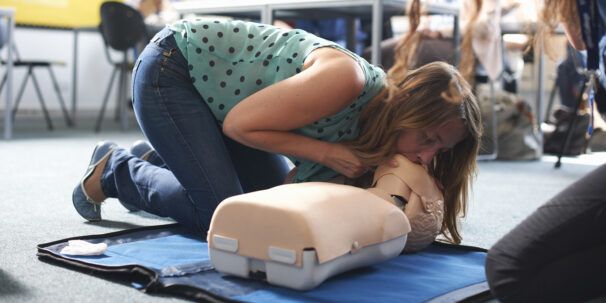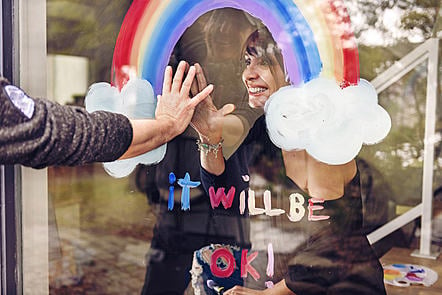How to do CPR: First aid and CPR training
If a person is experiencing cardiac arrest, your first action should always be to call an ambulance. By knowing how to perform CPR, you can provide help before emergency services arrive.

Cardiopulmonary resuscitation (CPR) can help someone suffering from cardiac arrest, keeping them alive until the emergency services arrive. In the UK, there are more than 30,000 cardiac arrests a year outside of hospitals, which means that members of the public are often called upon to help.
Learning how to do CPR and first aid is therefore incredibly important, as it can often be the difference between life and death. By giving someone chest compressions, you’re ensuring they have the best chance of survival.
In this article, we’ll look at the basics of CPR, including a step-by-step guide on how to perform CPR when someone stops breathing. Follow our guidance to ensure you’re best placed to take immediate action in an emergency situation.
What is CPR?
When someone’s heart is no longer able to pump blood and they’ve stopped breathing normally, CPR can save their life by restarting their heart under cardiac arrest. You do this by administering chest compressions using your hands, which helps assist the flow of blood to important organs in the body. This is performed until a regular heartbeat returns.
Learning how to do CPR can be daunting for some, but it shouldn’t be. The technique we describe in this article is actually fairly easy to perform and something that anybody can learn.
You might need to do CPR if someone:
- Collapses
- Isn’t breathing
- Doesn’t respond
- Doesn’t have a pulse.
72% of cardiac arrests occur either in a home or workplace environment, so CPR first aid is an essential skill to know, as you could be able to save someone’s life.




How to do CPR: quick reference
Before we get into more detailed steps about performing CPR, we are going to give you a top-line overview, which you can use as an easy point of reference.
CPR should be used on an adult if they’re not breathing, gasping for breath, or unable to respond when you’re asking them questions. For children and infants, CPR should be used when they’re not breathing normally and unable to respond.
Once you’ve determined whether CPR is required and the area is safe, you can then perform the following steps:
- Call 999 (or your national emergency number) yourself or get someone else to.
- Lay the individual on their back, tilt their head back, and open their airway.
- Check to see if they’re breathing. This can be done by listening to them, seeing if their chest is going up and down, and checking their pulse.
- Start performing CPR. Use a combination of chest compressions and rescue breaths to help keep them alive (see below for more details).
- Keep repeating this technique until the emergency services arrive.
Read on for more information in our mini CPR training step-by-step guide.
How to perform CPR step-by-step
Once you know how to do CPR, you’ll never look back. Your help could literally be the reason why someone suffering from cardiac arrest lives, so knowing how to perform CPR is invaluable.
In this section, we will ensure you receive detailed guidance to help you use CPR effectively. The way you perform CPR differs slightly depending on whether the individual is an adult, a child, or an infant. Below, we will focus on the steps you need to take in all three instances.
CPR steps for adults
1. Call 999 (or your national emergency number)
Assess your surroundings to check both yourself and the individual are safe. Next, tap their shoulder and ask if they’re ok. If they don’t respond, then give them the care they need while you call 999, or alternatively ask someone else to make the phone call.
2. Get them into position
Lay them on their back, before tilting their head back and opening their airway. Kneel beside them and remove any obstructions from their mouth and nose, such as food or vomit.
3. Check for breathing
Place your ear next to their mouth and listen for 10 seconds. If they’re not breathing or you hear repeated gasps for air, then you need to begin CPR.
4. Perform CPR
While kneeling next to them, place the heel of your hand on the breastbone at the centre of their chest. Take the palm of your other hand and place it on top of the hand that’s on their chest and interlock your fingers. Make sure you position yourself so your shoulders are directly above your hands.
Using your body weight, press straight down by 5 to 6cm on their chest. Keeping your hands on their chest, release the compression and allow their chest to return to its original position.
5. Repeat and wait for the emergency services
Repeat these compressions at a rate of 100 to 120 times a minute, around 2 per second, until an ambulance arrives or they start to become responsive and start breathing normally again.
The beat to the song “Staying Alive” by the Bee Gees is often recommended as a good rhythm and speed for chest compressions.
CPR steps for children over one year
1. Call 999 (or your national emergency number)
Check your surroundings to ensure both yourself and the child are safe. Next, tap the shoulder of the child and ask whether they’re ok. If they fail to respond, then give them the care they need while you call 999, or alternatively ask someone else to make the phone call.
2. Get them into position
Once you’ve checked to see if they’re breathing, lay them on their back and open the child’s airway by placing one hand on their forehead and gently tilting their head back and lifting their chin. You’ll also need to remove any obstructions from their mouth and nose.
3. Perform rescue breaths
Pinch the child’s nose and then seal your mouth over their mouth. Blow steadily and firmly into their mouth, while checking that their chest rises. Perform five initial rescue breaths.
4. Do chest compressions
Place the heel of one hand on the centre of the child’s chest and push down by 5cm (approximately one-third of the chest diameter). The quality (depth) of chest compressions is very important, so make sure you use two hands if you can’t achieve a depth of 5cm using one hand. After every 30 chest compressions at a rate of 100 to 120 a minute, give two breaths.
5. Repeat and wait for the emergency services
Continue with cycles of 30 chest compressions and two rescue breaths until the child shows signs of recovery or the emergency services arrive to take over.




CPR steps for infants under one year
1. Call 999 (or your national emergency number)
Take a look at your surroundings to ensure both yourself and the infant are safe. Next, flick the sole of their foot to see if they respond. If they fail to, then give them the care they need while you call 999. Alternatively, you can ask someone else to make the phone call.
2. Get them into position
If their breathing isn’t normal, then lay them on their back and open the infant’s airway by placing one hand on their forehead and gently tilting the head back and lifting their chin. Make sure you remove any visible obstructions from their mouth and nose.
3. Perform rescue breaths
Place your mouth over the infant’s mouth and nose and blow steadily and firmly into their mouth, checking that their chest rises while you do so. You should perform five initial rescue breaths.
4. Do chest compressions
Start performing chest compression by placing two fingers in the middle of the infant’s chest and pushing down by 4cm (approximately one-third of the chest diameter).
The quality (depth) of chest compressions is vital, so use the heel of one hand if you can’t achieve a depth of 4cm using the tips of two fingers. Once you’ve completed 30 chest compressions at a rate of 100 to 120 a minute, give two rescue breaths.
5. Repeat and wait for the emergency services
Continue with cycles of 30 chest compressions and two rescue breaths using the above technique until the infant begins to recover or the emergency services arrive to begin caring for them.
When to use CPR
Now you know how to do CPR, it’s important to know when to perform it. As we discussed earlier, CPR first aid should be used when an adult is not breathing at all or gasping for breath repeatedly.
For a child or infant, you should use CPR when they’re not breathing normally. In both cases, you should perform CPR if they’re not responding to the questions you ask them.
It’s important you consider the above before you start CPR, which is why it’s recommended that you ensure the person is not responding to verbal or physical calls to attention before you start the process.
While the risks of performing CPR unnecessarily are minimal, it can be traumatic and there is a chance that hard chest compressions could lead to broken ribs or injured organs, so make sure you carry out the necessary checks first.
What happens after CPR?
Once you’ve performed CPR, you’ll be able to hand over the care of the individual to the emergency services.
Hopefully, the person is alive and their breathing has returned to normal, but if they’re still struggling, then the first responders will take the necessary measures. Either way, the individual is likely to be taken to a hospital.
At this point, they’ll be able to determine what the cause of the cardiac arrest was and will be able to provide further treatment if required. By following the CPR training we have listed in our step-by-step guide, you’ll know that you’ve done everything in your power to help that individual stay alive.
CPR training: next steps
Hopefully, you’re now confident that you know how to do CPR and you’ve learnt a lot by reading this guide. The next step to take is to further your CPR training by taking part in an affiliated course.
At FutureLearn we offer a course in first aid and CPR which provides participants with the knowledge they need to be able to administer first aid to those who need it. We also offer a course that will teach you to give basic first aid to animals and pets.






